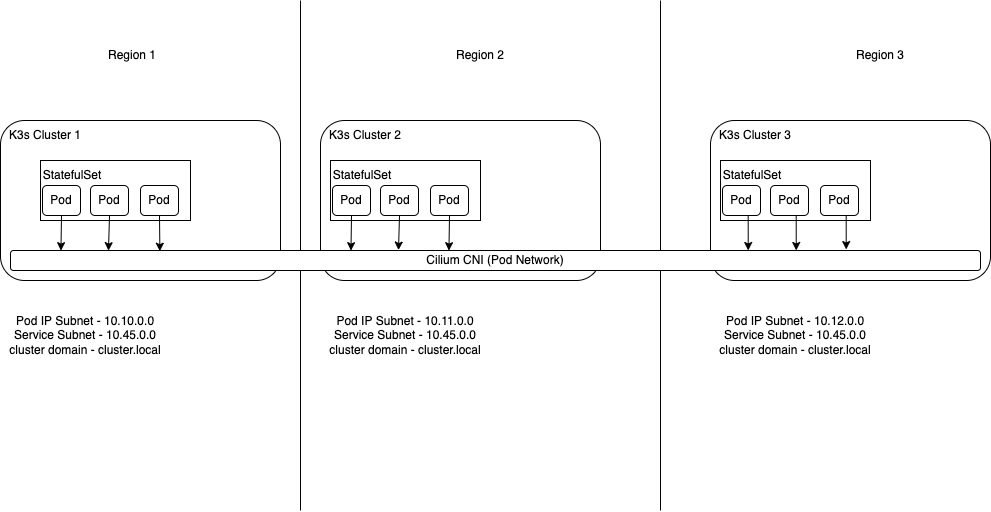In this demo you will deploy CockroachDB across three Azure Regions. A single Virtual Network will be deployed in each of the regions with VNet Peering in place between each of the Virtual Networks. Nine virtual machines will then be deployed across Azure, three in each region.
All three regions will be using k3s as the Kubernetes distribution. The k3s default Container Network Interface (CNI) of flannel will disabled in favour Cilium. One of the requirements to run CockroachDB in Kubernetes is network connectivity between the all of the Cockroach pods in all of the clusters. Out of the box in a typical multi-cluster deployment this type of connectivity may not be available. The pod network is typically isolated on each cluster. By adopting Cilium as the CNI we can take advantage of the Cluster Mesh capability which creates network connectivity between all of the configured clusters. This demonstrates one deployment pattern that can be used for a deployment of CockroachDB in a multi-region or multi-cloud deployment.
This solution will deliver the following requirements.
- The required infrastructure across the three regions in Azure.
- A k3s Kubernetes deployment to all three regions using the CLI tool k3sup.
- Cilium will be deployed as the Kubernetes Container Network Interface (CNI)
- CockroachDB is deployed as a stateful set in to each cluster.
To complete this demo you will already need the following.
This demo will create a Network Security Group for each region with the following security rules in each.
In your own deployment please consider updating the rules source address to limit connectivity to just your host IP address. This will tighten the security a great deal. This is a demo and should be built upon for any production deployment.
| Source | Destination | Port Number |
|---|---|---|
| * | Kubernetes API | 6443 |
| * | SSH Access to Each VM | 22 |
| * | NodePort Access | 30000-32767 |
Below is a high-level architecture diagram to show how the three regions are connected. In this solution we will be using the Cilium CNI (Container Network Interface) for Kubernetes to provide the required networking to connect our three k3s Kubernetes clusters. All regions need to have none overlapping address space along with the pod networks in our k3s Kubernetes clusters also not having overlapping address space. This is to ensure that routing is possible without any issues. All of the three regions need to be peered together to allow for communication between the pods in Kubernetes in all three regions.
Cilium's multi-cluster implementation in a nutshell, ClusterMesh provides:
- Pod IP routing across multiple Kubernetes clusters at native performance via tunneling or direct-routing without requiring any gateways or proxies.
- Transparent service discovery with standard Kubernetes services and coredns/kube-dns.
- Network policy enforcement spanning multiple clusters. Policies can be specified as Kubernetes NetworkPolicy resource or the extended CiliumNetworkPolicy CRD.
- Transparent encryption for all communication between nodes in the local cluster as well as across cluster boundaries.
To complete this demo there are a number of steps. These are listed below.
- Azure infrastructure setup
- Kubernetes setup
- Virtual Machine region setup
- Network test
- CockroachDB setup
First update the 'teardown.py' script with you kubernetes contexts as we did in the 'setup.py'. Once you have done this run the script. This is will tidy up your folder and remove any certificates for this deployment we no longer need.
python teardown.py
Creating resources in Azure costs money, so make sure you delete the Resource Group once you’re finished.
az group delete --name $rg
In conclusion there are a number of different way to achieve a Geo-Distributed Cockroach cluster but we believe that by adopting this solution it offers a simple and elegant solution. Kubernetes is already complex to manage without increasing the complexity by introducing technologies such as Multi-Cluster Service Mesh. By adopting a CNI that provides us with the ability to connect Kubernetes in a simple way with very little configuration it reduces the complexity and administrative overhead of managing the solution.
